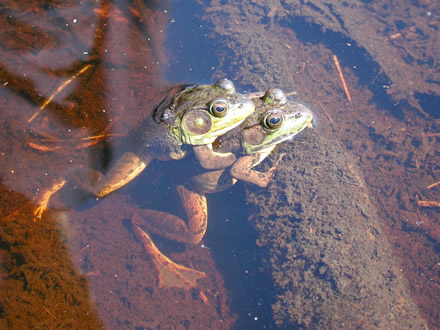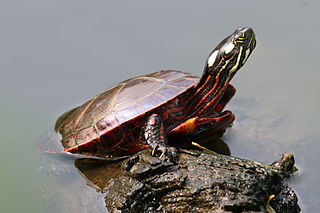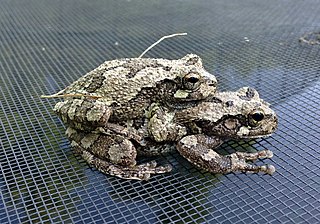I’ve always enjoyed keeping my herp pets, and those I’ve cared for in zoos, in outdoor ponds and exhibits. I see a wider variety of behaviors and have better breeding results, and the access to natural sunlight and wild insects is very beneficial for the animals. The arrival of winter, however, ends the fun and brings special challenges. Today I’ll cover indoor and outdoor hibernation of terrestrial and aquatic turtles and frogs, and review what to do if you wish to keep your pets active year-round.
General Considerations
Hibernation is risky under the best of circumstances. Each spring, I see evidence of winter die-offs among free-living reptiles and amphibians. The safest option for most pet owners is to keep your animals active and feeding throughout the winter.
Reptiles and amphibians native to temperate climates may not reproduce unless subjected to period of dormancy. However, in many cases a short, cool resting period will suffice – true “winter” in not needed. Details vary widely as to species, so please post below for further information.
It has been theorized that hibernation enhances the long-term health of those species that do so in the wild, but there seems to be nothing of substance published to this effect. During my long career in zoos, I’ve kept hundreds of temperate zone species active and breeding year-round for many years. In my personal collection, a number of North American natives, including 30-45 year-old-turtles and salamanders aged 20-35 years, have never experienced dormancy.
Animals subjected to hibernation must be healthy, well-hydrated, and possessed of ample fat reserves; a vet exam in early autumn is recommended.
Depending upon the species and the size of the individual, pre-hibernation preparation should include a fast of 1-4 weeks in duration (please post below for further information).
Outdoor Hibernation
Box Turtles and Toads
I’ve had good results by allowing Eastern Box Turtles and American Toads to dig down into the soil and leaf litter within their pens. However, the ground must be loosened in the fall, and I always add a 6-12 inch layer of fallen leaves to the surface. Note: although many people keep American Wood Turtles in largely-terrestrial pens, they spend the winter at the bottom of streams, not on land.
The pen should be exposed to rainfall year-round, as terrestrial turtles and toads require somewhat moist hibernation sites. Drainage must be provided…I’ve only left animals outdoors in bottomless pens, so that water does not pool.
Aquatic Turtles and Frogs
Red-Eared Sliders, Painted Turtles, Green Frogs, American Bullfrogs and similar species usually overwinter underwater, beneath mud and leaf litter. Unless you are well-experienced or have expert guidance, I would not recommend trying to keep these creatures outdoors for the winter.
Dormant turtles absorb oxygen via the cloaca, while amphibians utilize diffusion through the skin. Your pond water’s oxygen level is, therefore, critical, but we have little information on any species’ exact requirements. Water depth is also a concern.
Aerators and surface heaters designed for use with koi and goldfish can be employed if you wish to keep your aquatic pets outdoors. You can read more about general winter pond preparations on ThatFishBlog…please see the links below.
I have had success in overwintering some aquatic species outdoors (i.e. Sliders, Snappers, Musk, Mud, Spotted and Painted Turtles, Green and Bullfrogs, Northern Watersnakes) but my best results were in large outdoor zoo exhibits rather than backyard ponds.
In both my pens and natural situations, I was several times surprised to find American Bullfrogs and Green Frogs hibernating on land – they missed the “go to the pond memo”, I guess!
Indoor Hibernation
Indoor hibernation is a bit less risky in some ways, as you can monitor the animals closely and avoid the extreme conditions that occur outdoors. However, it is still not advisable for pet-keepers lacking considerable experience.
American Box Turtles can be over-wintered in moist sphagnum moss at 38-42 F. A refrigerator designated for this purpose is ideal, but attics, garages and similar areas can be used if temperatures are appropriate. American Toads and their relatives can be maintained in the same manner, but they usually remain active and feeding down to 55 F or so, and so are easier to “keep awake”.
Keeping your pets in an unheated or extra-cool room of the house is not satisfactory. At temperatures too low for normal activity, yet above those needed for dormancy (i.e. 50-65 F for many temperate zone species), food reserves are used and the immune system fails to protect from respiratory and other infections.
While aquatic turtles and frogs have been successfully over-wintered in aerated water at 40 F, I would not advise taking the risk.
Avoiding Hibernation
Spotted, Wood, Box and Painted Turtles, and others with similar life histories, may be kept active at their normal temperatures year-round. I tend to maintain them at the lower end of their normal active range, but provide a warmer basking site. If the animals are in good health, a dip to 60 F at night will do no harm (different species vary in this regard – please post below for specific information).
Temperate zone frogs and toads, including Fire-bellied Toads, American Bullfrogs, Gray Treefrogs and Leopard Frogs remain active and feeding at normal to low (i.e. 55 F) room temperatures. The change from summer highs seems to do them good, and in some cases (i.e. Fire-bellied Toads), may also stimulate breeding behavior.
Tortoises
Russian and Greek Tortoises, along with several other species, experience cool to cold winters in some portions of their natural ranges. However, it is difficult to successfully induce dormancy among captives, either in the home or outdoors. Please post below if you wish to attempt this, and I’ll send along specific information.
Internal Controls on Behavior
Circadian rhythms, which might be likened to “internal clocks”, govern behavior to varying degrees. For example, Indian Gharials under my care for 14 years refused food in tune with the cool season in their native range, despite being kept at optimal temperatures (they lost virtually no weight during the 3 month period, however).
Among pets, wild-caught individuals of certain species may refuse food and become less active even when kept warm during the winter. In some cases, captive-born youngsters of the same animals will feed normally all winter long. Captive born individuals of other species may enter semi-dormancy despite being many generations removed from the wild. For species with large ranges, the origin of the parent stock may be important. I’ve had experience with this scenario in a number of reptiles and amphibians, and am very interested in learning more…please post your observations and questions below.
Further Reading
 That Reptile Blog – Reptile, Amphibian and Exotic Pet Care and Information
That Reptile Blog – Reptile, Amphibian and Exotic Pet Care and Information








Hey Frank,
Great info as usual.
I have a Russia tortoise approximately 25 years old. I have had him for about 12 years. He lives outside except when it rains. He successfully hibernated on his own for about 9 years and I would put him a cardboard box for safekeeping. One year he was poorly with a swollen leg and needed antibiotics so I kept him in an indoor habitat (in a cold room) for about 6 weeks. He mostly slept but I gave him soaks and turned on the uvb light after every 10 days or so. I have done this for a few years now. I am planning on doing the same thing this year.
Do you have any comments or suggestions?
@modelthetortois
Hi Kim,
Thanks for the kind words, and nice to see you here.
It’s always a tough decision. There are concerns with a room that is cool but not cold enough for true hibernation – certain pathogens may be active, but immune system is depressed, etc. But hibernation ha risks also. I’ve kept several temperate zone species as you describe – cold room – with good results, but most advise against it. In zoos we either hibernate or keep active. Some animals feed little even at high temps during winter, but they come through fine, w/o much weight loss. I kept a common musk turtle at 62-66 for over 20 years w/o incident; then it developed a lung infection and nearly died (fine now, at age 45!). Sorry I could not give a more definitive answer…let me know what you decide, best, Frank
Hello Mr. Indiviglio,
Today I noticed that my Tiger Salamander is behaving oddly. Normally he comes right up to the glass whenever anyone approaches him but recently he seems sluggish and unresponsive. Where as before he would track any movement in the enclosure and try to eat anything moving near his mouth, now he doesn’t react much. I found that he had spit out a roach that I thought he had eaten the other day and he looks to be a little bloated around the main body area. I know they tolerate colder conditions quite well so I wasn’t concerned when the temperatures dropped to the low 60s before the house heater kicked on and brought it back up to 70 or so. Have you seen anything like this in your years of working with amphibians? Thanks.
Cheers, Alex
Hello Alex,
Generally they do best at low temps – 55-65F ideal for most (some differences, depending on origin); if the animal regurgitated and appears bloated an infection of blockage, or other health problem, may be involved. Unfortunately there is no way to diagnose other than via a vet visit. If the animal was kept at warm temperatures, a sudden dip could cause some disruption in feeding, but from what you describe I suspect a medical concern. Please keep me posted, best, Frank
When I wrote that first line he was still alive, but after about 20 mins I went to check on him again and he had died. He looked a bit desiccated and had some milky-white patches on him which at first I assumed was a kind of fungus but disregarded that since 20 mins is way to fast for it to develop to that extent. While I was removing him and cleaning the enclosure the ooze that was all over his body seemed very slick and slimy at first touch but then got sticky. It was a good thing I used gloves since it stuck both fingers together quite well. Could that ooze have been skin toxins that he had excreted? Have you ever seen anything like what I have described? I would send you pictures if I could, but this text box doesn’t have that option. I made sure to sterilize his enclosure and any equipment in it with a good alcohol wash in case his condition was caused by pathogens. Odd how hours later I would see your post about a new fungus spreading among salamanders and newts.
Cheers, Alex
Hello Alex,
Yes, skin toxins are often secreted upon death.
Know way to be sure w/o tests, but often an internal bacterial infection is involved. Fungi often colonize the animal after that, once it is weakened. Bacteria and fungi of many types are always present.; most do not become dangerous until the immune system is weakened for some reason. A common cause of this in pets is ammonia toxicity. Ammonia is excreted by the salamander; if the water and substrate are not cleaned frequently, ammonia builds up and poisons the animal (absorbed through skin) or irritates the skin, leaving it open to attack by baceria etc. Please let me know if you need more info, best, Frank
This is a great article! I found it to be very informative. I have several herps that live in and around my koi pond that have “showed up”. I worried about them the first year but they always show up again the following year. I have been successful in “hibernating” my snakes. I don’t attempt it with most of them though. Thanks again for a great article!
Much appreciated!